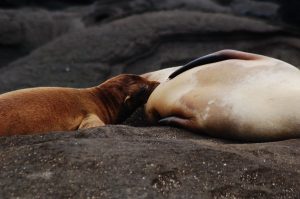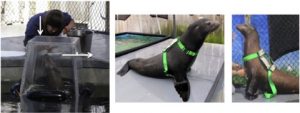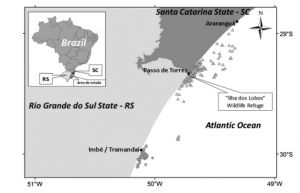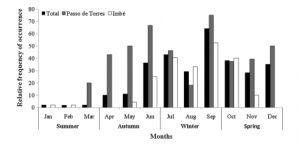Energetically Pricey Lifestyles and Low Productivity Environments: How the Galapagos Sea Lion Makes Ends Meet
By Patricia Albano, SRC Intern
Metabolic rate and prey acquisition behavior can be revealing factors in studies examining physiological adaptations to unpredictable environments. Specifically, otariids (sea lions and fur seals) display an energetically expensive lifestyle due to their high costs of thermoregulation which can provide challenges in equatorial regions such as the Galapagos where resources are limited and unpredictable. In this study (conducted by Stella Villegas-Amtmann et. al, 2016), the effect of the Galapagos islands’ low productivity on the Galapagos sea lion (GSL) (Image 1) is explored. To determine how sea lions maintain their energetically expensive lifestyle in limiting environments, researchers measured the field metabolic rate (FMR) and the foraging behavior of lactating female sea lions rearing pups and yearlings. Because lactation is the most energetically costly time in a female mammal’s life history (Hammond and Diamond, 1997; Williams et. al, 2007), the researchers hypothesized that GSL would exhibit a lower FMR in relation to other species as a response to decreased resource availability (Trillmich and Kooyman, 2001), but lactating GSLs rearing yearling pups would display greater FMRs and foraging efforts than those rearing younger pups (~1 year old). This hypothesis was drawn based on literature that suggests that there is a positive relationship between female energy expenditure and pup mass/age before the weaning period at ~3 years of age (Jeglinski et al., 2012; Trillmich, 1986a).

Suckling Galapagos sea lion (Zalophus wollebaeki) pup and lactating mother. Source: Wikimedia Commons.
This research was carried out at San Cristobal Island during October and November of 2009. 10 lactating female GSLs and their pups/yearlings were caught using hoop nets. Of the 10 pups, 6 were suckling young pups (~ 1 month old) and the other 4 were suckling yearlings. To analyze prey acquisition behavior, the animals were fitted with GPS tags, time-depth recorders, and radio transmitters. For each sea lion, the researchers calculated % shallow dives (100m depth), mean depths for shallow and deep dives, dive duration, bottom time, maximum distance traveled from the rookery, and time spent diving. Results show that GSLs with yearlings dove further, deeper, and longer than GSLs with younger pups (Table 1). The field metabolic rate measurement of the seals exhibited the same relationship: females with yearlings had a higher FMR than those with young pups. These results confirm the researchers’ hypothesis that GSLs with yearling pups would have a more energetically costly lifestyle than females with younger pups.

Galapagos sea lion females’ foraging location, maximum dive parameters, and mean foraging trip parameters. This table includes the age categories of the females’ pups so the relationship between pup age and energy expending activities can be seen. Source: Villegas-Amtmann, S., et al., Adapted to change: Low energy requirements in a low and unpredictable productivity environment, the case of the Galapagos sea lion. Deep-Sea Res. II (2016).
This study shows a remarkable ability of sea lions to reduce their metabolic needs to adapt to the low productivity ecosystem of the Galapagos islands. However, while this species shows an impressive plasticity in responding to environmental changes, in comparison to other higher latitude ostariids, endangered GSLs live in an environment that requires them to exert a significantly greater amount of effort in order to maintain their and their offspring’s metabolism. If warming trends in equatorial waters continue and productivity in the Galapagos proceeds to decrease (Bopp et al., 2013), GSLs already functioning at their lower physiological limit may not be able to adapt further.
Works Cited
Hammond, K.A., Diamond, J., 1997. Maximal sustained energy budgets in humans and animals. Nature 386 (6624), 457–462.
Trillmich, F., Kooyman, G.L., 2001. Field metabolic rate of lactating female Galapagos fur seals (Arctocephalus galapagoenis): the influence of offspring age and environment. Comp. Biochem. Phys. A 129 (4), 741–749.
Trillmich, F., 1986a. Attendance behavior of Galapagos sea lions. In: Gentry, R.L., Kooyman, G.L. (Eds.), Fur Seals: Maternal Strategies on Land and at Sea. Princeton University Press, Princeton, New Jersey, pp. 196–208.
Villegas-Amtmann, S., et al., Adapted to change: Low energy requirements in a low and unpredictable productivity environment, the case of the Galapagos sea lion. Deep-Sea Res. II (2016), http://dx.doi.org/10.2016/j.dsr2.2016.05.015
Williams, T.M., Rutishauser, M., Long, B., Fink, T., Gafney, J., Mostman-Liwanag, H., Casper, D., 2007. Seasonal variability in otariid energetics: implications for the effects of predators on localized prey resources. Physiol. Biochem. Zool. 80 (4), 433–443.


![Study area for the case study which shows the Bonneville Dam and the East Mooring Basin where the males aggregate [Schakner et al., 2016]](https://sharkresearch.rsmas.miami.edu/wp-content/uploads/2017/04/Figure-1-SRC-300x112.png)
![A California sea lion (Zalophus californianus) goes for a swim [Wikipedia Commons]](https://sharkresearch.rsmas.miami.edu/wp-content/uploads/2017/04/Figure-2-SRC-300x225.jpg)

